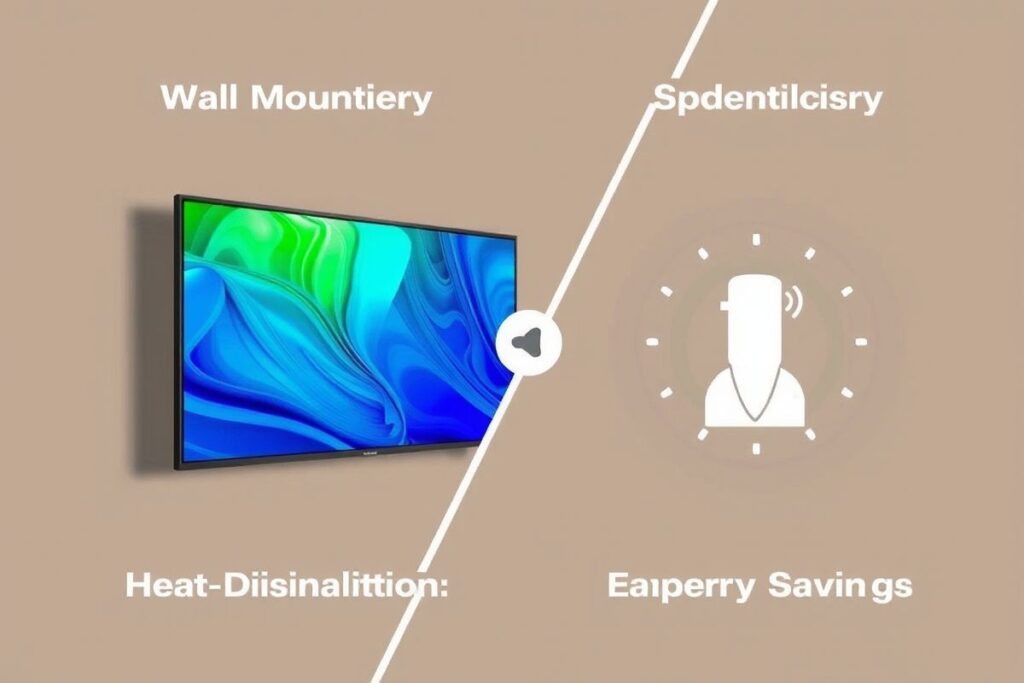Mounting your TV on the wall offers a sleek, modern aesthetic and saves valuable floor space. But does this design choice impact the TV’s performance, specifically its heat dissipation and energy efficiency? This is a question many homeowners grapple with. While wall mounting provides undeniable aesthetic benefits, it’s essential to understand the potential implications for your television’s longevity and power consumption. This article delves into the relationship between wall-mounted TV efficiency, heat dissipation, and energy savings, providing you with the knowledge to make informed decisions about your home entertainment setup. We’ll explore the science behind heat management in modern TVs and how mounting affects it. Furthermore, we’ll examine the potential impact on energy usage and offer practical tips for optimizing your wall-mounted TV for both performance and efficiency.

Heat Dissipation and Wall-Mounted TVs
Understanding TV Heat Production
Modern televisions, especially LED and OLED models, generate heat during operation. This heat is a byproduct of the electrical processes that create the images we see. Effective heat management is crucial for the longevity and performance of these intricate electronic devices. Excessive heat can damage internal components, leading to premature failure or reduced lifespan.
The amount of heat generated varies depending on the TV’s technology, size, and brightness settings. Larger screens and higher brightness levels generally produce more heat. Understanding these factors can help you anticipate potential heat-related issues with your wall-mounted TV.
Different display technologies also influence heat production. OLED TVs, known for their vibrant colors and deep blacks, typically generate less heat than traditional LED TVs. This difference stems from the self-emissive nature of OLED pixels, which don’t require a backlight.
The Impact of Wall Mounting on Heat Dissipation
Mounting a TV on the wall can restrict airflow around the device, potentially hindering its ability to dissipate heat effectively. This is particularly true if the TV is mounted flush against the wall, leaving minimal space for ventilation. Reduced airflow can lead to heat buildup, which, as mentioned earlier, can negatively impact the TV’s performance and lifespan.
The type of wall mount also plays a role in heat dissipation. Fixed mounts that hold the TV close to the wall offer the least ventilation. Tilting and full-motion mounts provide more space behind the TV, allowing for better air circulation.
Proper ventilation is key to preventing heat-related problems. When mounting your TV, ensure there’s adequate space between the back of the TV and the wall. Even a small gap can significantly improve airflow and help dissipate heat.
Optimizing Airflow for Wall-Mounted TVs
Several strategies can enhance airflow and prevent heat buildup in wall-mounted TVs. Using spacers to create a small gap between the TV and the wall is a simple yet effective solution. These spacers can be purchased online or at most electronics stores.
Another approach is to choose a wall mount that allows for tilting or articulation. These mounts provide greater flexibility in positioning the TV, enabling you to optimize airflow based on the room’s layout and ventilation.
Ensuring adequate ventilation in the room itself is also crucial. Proper air circulation within the room can further aid in dissipating heat from the TV and other electronic devices.
Energy Savings and Wall-Mounted TVs
Does Wall Mounting Affect Energy Consumption?
Wall mounting itself does not directly impact a TV’s energy consumption. The primary factors influencing energy usage are screen size, brightness settings, and the TV’s technology (LED, OLED, etc.). However, indirect factors related to wall mounting can play a role.
For instance, if mounting the TV in a brighter room necessitates increasing the brightness setting to maintain picture quality, this will naturally increase energy consumption. Conversely, if wall mounting allows for better cable management and reduces clutter, it could indirectly lead to lower energy use by eliminating phantom loads from connected devices.
The impact is generally minimal, but it’s worth considering the overall setup and how it might affect your energy bill. Optimizing brightness settings and managing connected devices are more significant factors in controlling energy usage.
Tips for Energy-Efficient Wall-Mounted TVs
Regardless of whether your TV is wall-mounted or placed on a stand, several strategies can help minimize its energy consumption. Adjusting the brightness settings to suit the ambient lighting conditions is a simple yet effective way to save energy. Lowering the brightness in darker rooms can significantly reduce power usage without compromising picture quality.
Enabling energy-saving features, such as automatic brightness control and sleep timers, can further optimize energy efficiency. Many modern TVs offer these features, which can automatically adjust settings based on viewing conditions or turn off the TV after a period of inactivity.
Unplugging connected devices when not in use can also save energy. Many devices draw power even when turned off, contributing to phantom loads. Using a power strip with a switch makes it easy to cut power to multiple devices at once.
| Factor | Impact on Heat Dissipation | Impact on Energy Savings |
|---|---|---|
| Wall Mount Type | Significant | Minimal |
| Room Ventilation | Moderate | Minimal |
| TV Brightness | Minimal | Significant |
- Choose a wall mount that allows for adequate ventilation.
- Optimize brightness settings to suit the ambient lighting.
- Enable energy-saving features on your TV.
While wall mounting offers significant aesthetic and space-saving advantages, it’s crucial to consider its potential impact on your TV’s heat dissipation and energy efficiency. By following the tips outlined in this article, you can optimize your wall-mounted TV setup for both optimal performance and energy savings, ensuring your entertainment system runs smoothly and efficiently for years to come.

Leave a Reply